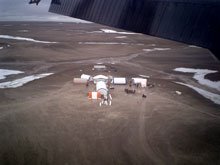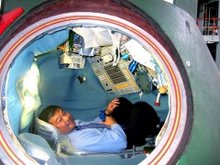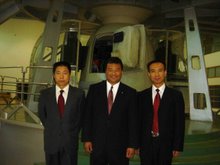Devon Island Expedition

This blog features educational updates on my Devon Island Expedition of July 14-20, 2007. Other sites: spaceref.com/blogs/earthclassroom, www.marsonearth.org

Thursday, December 1, 2011
Originally Published in Air and Space Smithsonian Online Magazine in September 2011
China and Human Spaceflight: One Look Back and Another Forward
Leroy Chiao
9/30/11
On September 29, 2011, a Long March 2F rocket roared to life, and lifted Tiangong-1 (TG-1, “Heavenly Palace”) into orbit. TG-1 was designed for a two-year life, and will be used as a docking target and as a small human-tended space station. This launch marked the beginning of China’s next phase in human spaceflight (HSF).
China’s foray into human spaceflight began in the late 1960’s, with Chairman Mao’s selection of the first group of Chinese National Astronauts. Economic and technologic realities prevented China from then achieving human spaceflight, but the legacy was born. Fast-forward twenty-five years, to the beginning of Project 920. This program sought initially to place China’s first astronaut into orbit in 1999, to coincide with the fiftieth anniversary of the founding of The People’s Republic of China. Project 920 did achieve the dream, albeit four years late. But, it was a significant achievement nonetheless. In October 2003, Yang Liwei became the first Chinese national astronaut, and China became only the third nation in the world capable of launching her own astronauts into space.
Now, nearly eight years later, China’s HSF program is on a steady course. One could argue that the pace of achievement has been slow, but we should consider the landscape to understand why. First: The main reason that any country gets into the HSF business is national prestige. The former Soviet Union struck first with the flight of Yuri Gagarin, on April 12, 1961. They wished to demonstrate their technological prowess, against the backdrop of the Cold War. The United States countered several weeks later, with Alan Shepard’s suborbital Mercury flight, followed by Gus Grissom, and then by John Glenn’s orbital mission. The Space Race was born, and the United States had not looked back, until now. Second: The United States has terminated the Space Shuttle program, and now has no ability to launch astronauts into space. Russia has become the only launch service for crews to the International Space Station (ISS), and their program recently suffered a launch failure of a Soyuz rocket, thus temporarily grounding their fleet. True, the United States has called for, and is funding, commercial ventures that seek to take over the crew and cargo transportation services to the ISS. But these efforts are realistically still at least five years away from Initial Operational Capability (IOC), and the jury is still out on whether or not they will be successful at all.
Taking these facts into account, it is easy to understand why China has acted slowly and deliberately. The three flights that they have flown to date have all been demonstrations in advancing capability. Yang Liwei’s mission showed their initial HSF ability. Shenzhou-7 demonstrated that their spacecraft and crews were capable of mounting missions of several days in duration. Shenzhou-8 demonstrated their first EVA (Extra-Vehicular Activity, or spacewalk), even if it only lasted about seventeen minutes (as opposed to American and Russian EVA’s, which typically are planned for six-and-a-half hours). They have maximized public exposure of their missions, and limited their exposure to risk of failure, by flying only once every few years. This is not the most efficient path for growth, but one could argue that they have been successful.
What does China have planned for the future? They have made no secret of their desire to build a space station. Indeed, China had, in their early days of HSF, talked openly about joining the ISS program. Their overtures were rebuffed by the United States. First, on the grounds that China’s technology was not mature. This is simply not true. In 2006, I became the first American to visit the Astronaut Center of China (ACC). There, I met the Center Director, and several of their first astronauts, including Yang Liwei. I toured firsthand, their center and saw examples of their advanced technological state [REFERENCE A&S ARTICLE THAT I WROTE IN JANUARY 2007?]. The control panel of the Shenzhou spacecraft simulator was modern, featuring multiple display screens which appeared to be re-configurable. The Center itself was up-to-date and clean. What they lack is operational experience. The second reason given for not working with China had to do with the fear of military technology theft. This is illogical, since our partnership with Russia has not resulted in any such technology transfer, in either direction. Why then, would it occur with China?
In any event, China’s actions have made it clear that they will continue with HSF. Each successive mission has built on the experience of the previous, and has represented a step forward in capability. Yang’s one-day flight aboard Shenzhou-5 achieved HSF for China. Shenzhou-6 demonstrated China’s ability to fly a crew of two for several days. Shenzhou-7 featured a crew of three, and demonstrated China’s first spacewalk, using their own spacesuit. Now that Tiangong-1 has been placed into orbit, two subsequent un-crewed Shenzhou missions will test Automated Rendezvous and Proximity Operations (ARPO) and docking technologies. These flights will be followed next year with crewed demonstrations of ARPO and docking capabilities. If successful, these missions would give China the same operational rendezvous and docking capabilities as the Russian have with their Progress and Soyuz vehicles. Going forward, China has announced plans to use TG-1 as a human-tended station, where visiting crews would live and work aboard the laboratory for periods of around two weeks.
China is continuing with the development of the Long March 5 (LM-5) rocket, a heavy-lift vehicle, which features a cryogenic core stage. The development of cryogenic engines is another indicator of advanced technical capability. China’s launch site on Hainan island, which is currently being developed, will give China the ability to easily launch into a five-degree inclination, which is ideal for lunar trajectories. China has announced that in 2020, once the LM-5 and the Hainan launch facility are completed, they will launch their first space station core module, which is approximately the size and shape of the core module of the ISS. However, this will be no mere copy. They are working on an advanced closed-loop life support system, and other capabilities, and have released drawings show multiple modules that would be added as their program progresses.
What should the United States do? I believe that we have an opportunity right now to again seize the leadership role in HSF, by bringing China into the ISS program, and to include them, with our other international partners, in future exploration missions. The US has the unique ability to integrate the world’s space programs. China sent the Chang’e-1 space probe to the Moon in 2007, which returned striking high-definition images. It’s sister spacecraft Chang’e-2 was launched to the Moon in October 2010. Although there have been no official announcements, I believe that China has lunar HSF ambitions. The Moon is an important part of Chinese culture, and landing on the Moon would demonstrate technological and operational expertise. This of course, would return enormous national prestige. Doesn’t it make sense for the United States to lead these explorations? After all, we are the only people who have been there.
Leroy Chiao served as a NASA astronaut from 1990-2005. During his 15-year career, he flew four missions into space, three times on Space Shuttles and once as the copilot of a Russian Soyuz spacecraft to the International Space Station. On that flight, he served as the commander of Expedition-X, a six and a half month mission. Dr. Chiao has performed six spacewalks, in both US and Russian spacesuits, and has logged nearly 230 days in space. He has performed scientific investigations in orbit, and helped to construct the International Space Station. Dr. Chiao was the first Chinese-American professional astronaut, spacewalker and mission commander.
Subscribe to:
Post Comments (Atom)





2 comments:
Google and Verizon are paired up with several others to broadcasted radiowaves and nanolaser technology on people and this is covid!
Please spread the word about covid satellites broadcasting radiowaves and nanolaser technology on our people worldwide! Its covid or co-video not the corona virus. Satellites are being used for augmented research and Artificial intelligence they use this on the public to hurt and kill mostly for the medical field and research. "DAVE" is digital audio visual enhancement that is used on covid people and they have great visualization and memory. Also many sicknesses and death can come from this exposure, I've been exposed to this since September of 2008 when SpaceX and Elon musk sent up Falcon 1! Everything is hacked by Google because they paired with Elon and the medical field. Do some homework and get an oscilloscope! Please spread the word
Post a Comment